(2023)
What does the opening clause mean?
With deferred taxation, there can be unfair over-taxation if a self-employed person has paid contributions to an occupational pension scheme over several years that were higher than the annual maximum contribution in the statutory pension insurance (sum of employer's and employee's share). The maximum amount payable is based on the contribution assessment ceiling.
This is recalculated annually and represents the limit up to which pension insurance contributions must be paid as a proportion of income. For income above the contribution assessment ceiling, you normally do not pay insurance contributions – unless you pay them voluntarily in this context.
The self-employed person has therefore voluntarily paid additional contributions from their already taxed income. As a result, they have earned a higher pension, but on the other hand, they would have to tax it too highly with the usual tax rate. This can be avoided. As a pensioner, they can have their pension divided into a voluntary and a statutory part. However, they must have paid higher voluntary contributions for at least ten years by 31/12/2004.
If this applies to you, you must apply for the portion of your pension based on these increased contributions to be taxed not at the high tax rate (2023: 82.5 percent of the pension) but at the much more favourable yield rate. The portion of the pension to be taxed at a lower rate is the opening clause, which you can find in the certificate from your pension provider.
If you have been receiving a statutory pension of 1,500 Euro per month since the age of 65 and can prove to the tax office with a certificate from the pension payment office that 30 percent (this is the opening clause) of the pension payment is based on increased contributions, the calculation is as follows:
For 70 percent of the pension: Normal taxation after deduction of the pension allowance: 1,500 Euro x 70 percent = 1,050 Euro x 12 months = 12,600 Euro minus pension allowance of (for example) 42 percent = 7,308 Euro.
For the part for which the opening clause of 30 percent applies, the more favourable yield rate is applied: 1,500 Euro x 30 percent = 450 Euro x 12 months = 5,400 Euro x 18 percent = 972 Euro. In this case, 8,280 Euro would have to be taxed. Without the opening clause, 10,440 Euro would have had to be taxed.
The yield rate depends on the age of the pensioner at the start of the pension payment, for example, it is 19 percent for 64-year-olds, 18 percent for 65 to 66-year-olds, and 17 percent for 67-year-olds.
The following table shows the yield rate depending on the age at the start of the pension; this is automatically calculated by SteuerGo:

In May 2021, the Federal Fiscal Court (BFH) published rulings on the possible double taxation of pensions (BFH rulings of 19/5/2021, X R 33/19 and X R 20/21). These affect all those who were already pensioners in 2005 and all future pensioners. The BFH has ruled that double taxation is only possible in a few cases. This means that the way pensions are taxed is generally accepted.
However, there are some disagreements about how exactly double taxation should be calculated. The BFH uses a simple method that focuses on the actual contributions and the later pension payments. Some experts and plaintiffs prefer a more complex method that takes the actual pension amount into account at a later date.
The good news is that the federal and state governments have decided to make tax assessments provisional regarding the disputed taxation of pensions. This means that pensioners now receive tax assessments stating that the tax assessment is provisional. If the Federal Constitutional Court decides that the current taxation is too high, tax assessments can be changed even without a prior objection (BMF letter of 30/8/2021, V A 3 - S 0338/19/10006 :001).
It is important to note that affected pensioners should keep all tax and pension statements, regardless of the final court decision.
Bewertungen des Textes: Was bedeutet die Öffnungsklausel?
4.17
von 5
Anzahl an Bewertungen: 6